Vincci Valdecañas Golf
As we were travelling through Spain, we stopped in a secluded and little know place near Valdecañas de Tajo, which is near the city of Cáceres.
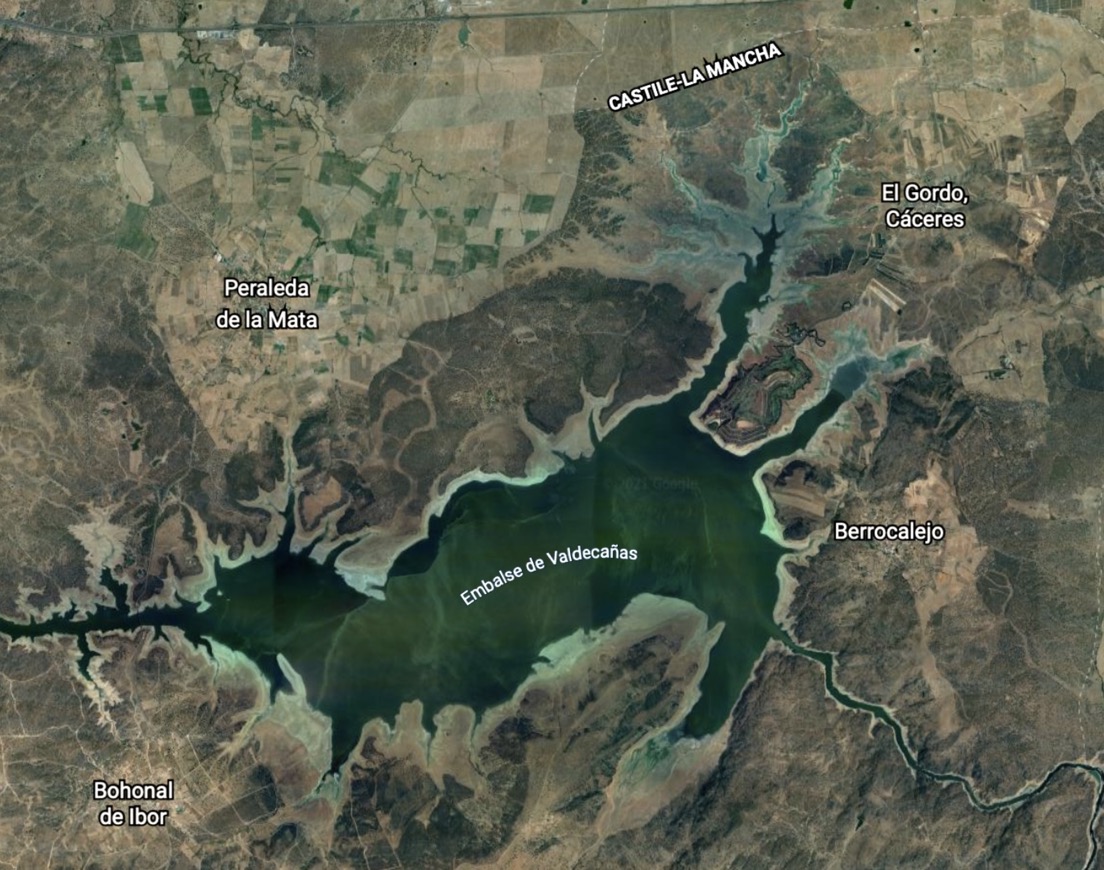
The hotel was the Vincci Valdecañas Golf, a 4-star golf hotel that lies on a small island located between the municipalities of El Gordo and Berrocalejo, in Cáceres. The exclusive private island called Marina Isla de Valdecañas has an area of 133 hectares and is surrounded by the Valdecañas reservoir.
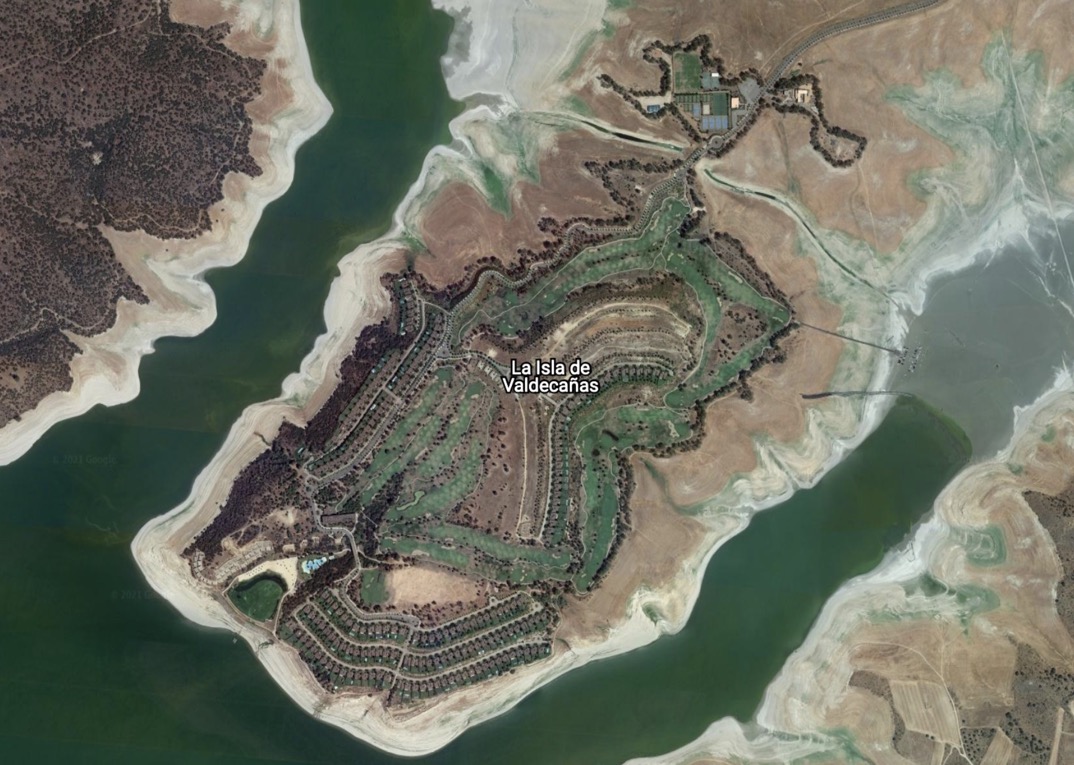
The Vincci hotel chain claims that the site is only 164 kilometres from Madrid, and that it hosts houses, an 18-hole golf course, water sports, swimming pools, horse riding, an artificial beach (temporarily closed), hiking routes and a fully equipped sports centre (as well as the hotel). We can see below how the site is often presented, however this description is not totally truthful in that the site itself has been the subject of numerous legal battles, that have left the island in a less than perfect condition.
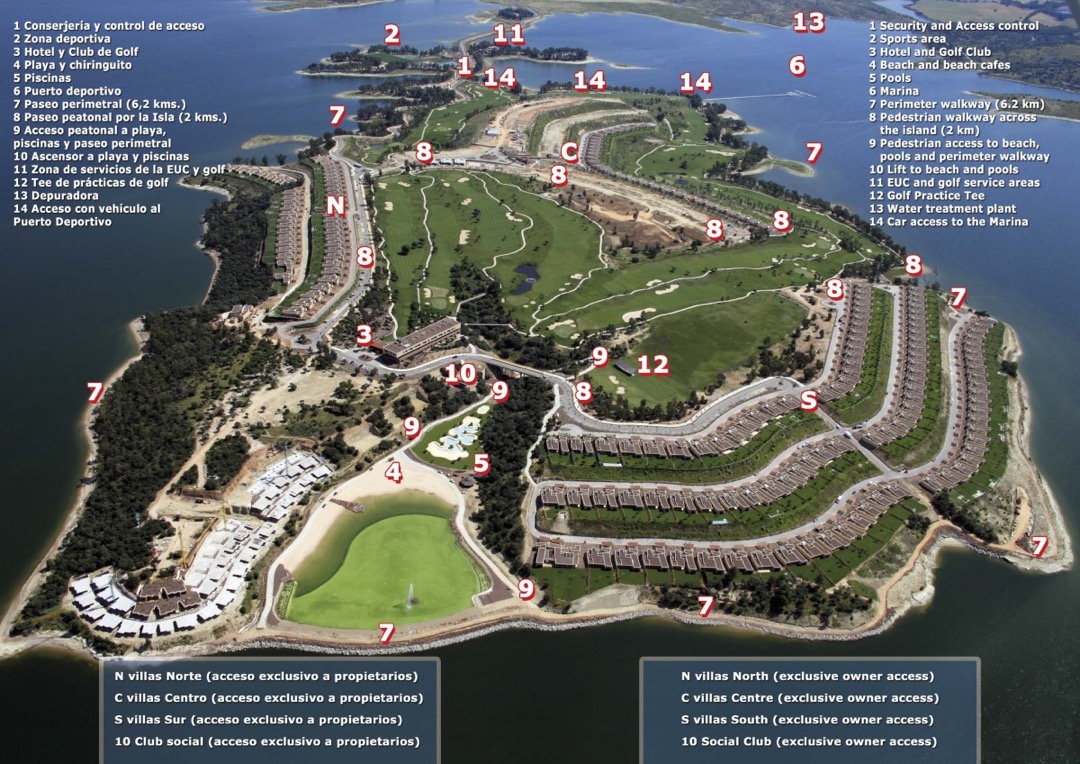
Firstly I will describe our stay, and at the end of this webpage I have included a section on the history of the site and the legal battles that were only (almost) put to rest in 2020.
The hotel
The hotel address is Carr. el Gordo, km 5, 10392 Barrcalejo. You find this type of address occasionally, and it often means that the access road to the site is at the 5 km point along a road from Barrcalejo to El Gordo.
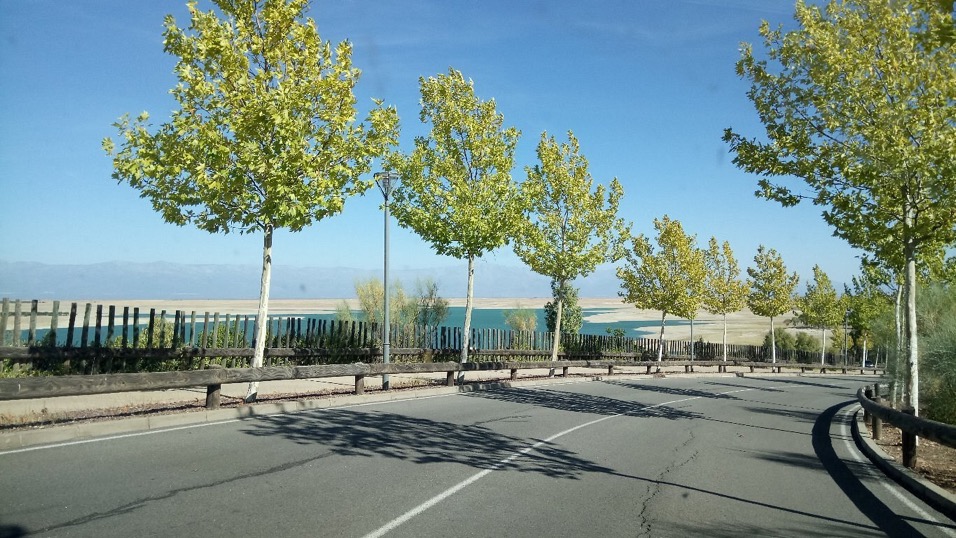
The hotel was more or less at the end of a 1.5 km drive into what they called the Isla de Valdecañas, a semi-island set within a large artificial reservoir called the Embalse de Valdecañas.
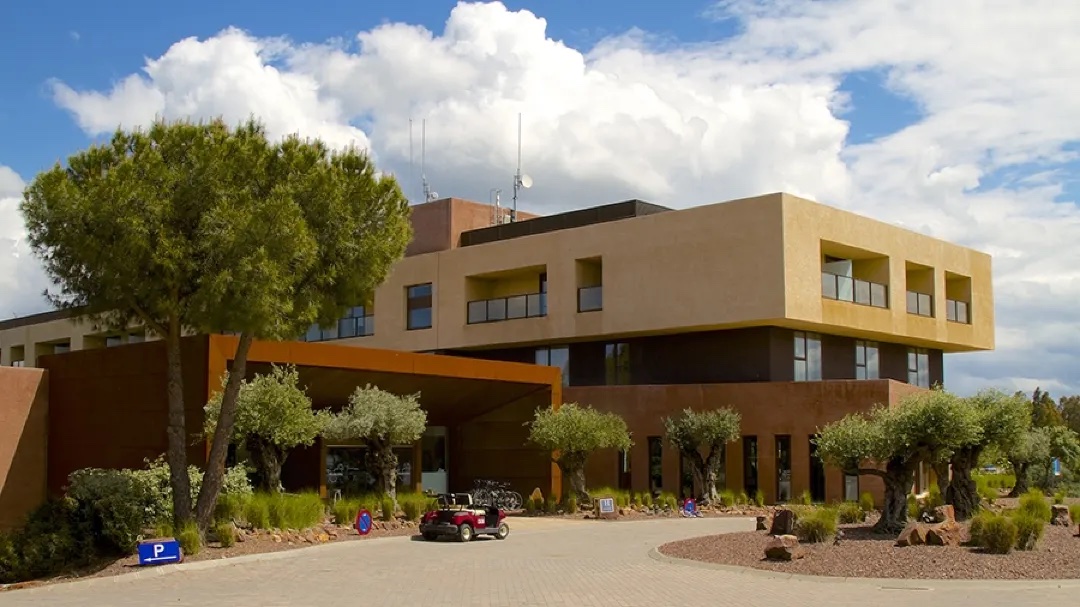
We can see that the architect has not made a masterpiece, so let's call it a 20th century shoe-box look.
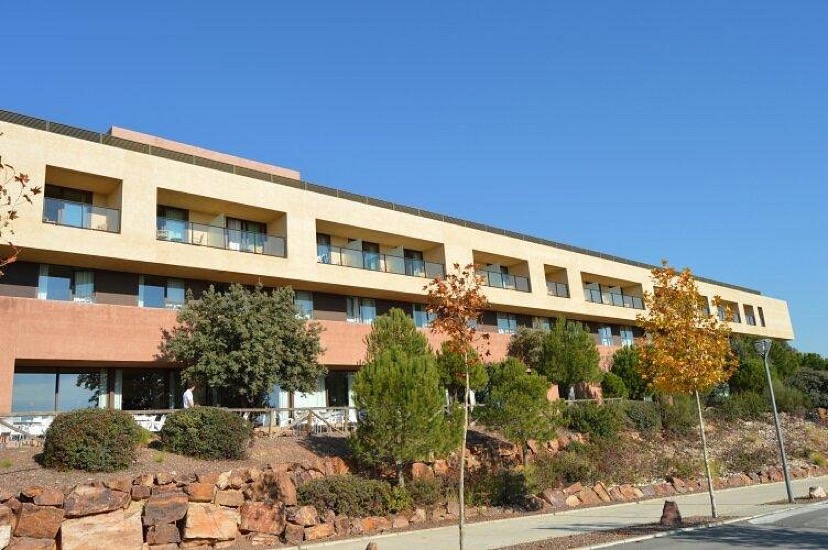
However, inside the hotel the layout and decor was pleasant, and the reception was reasonably friendly. When we arrived the two shops had their glass walls in place, so it did not look as bright and airy as in the photograph below. However, the overall impression of the public spaces was one of simplicity and functionality.
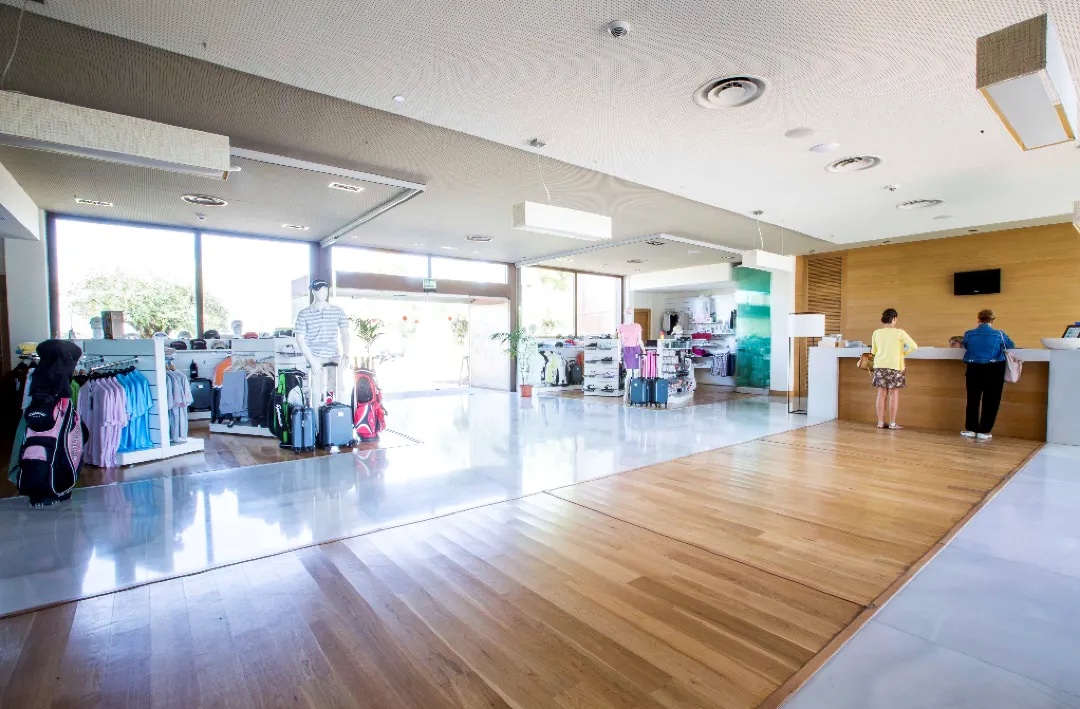
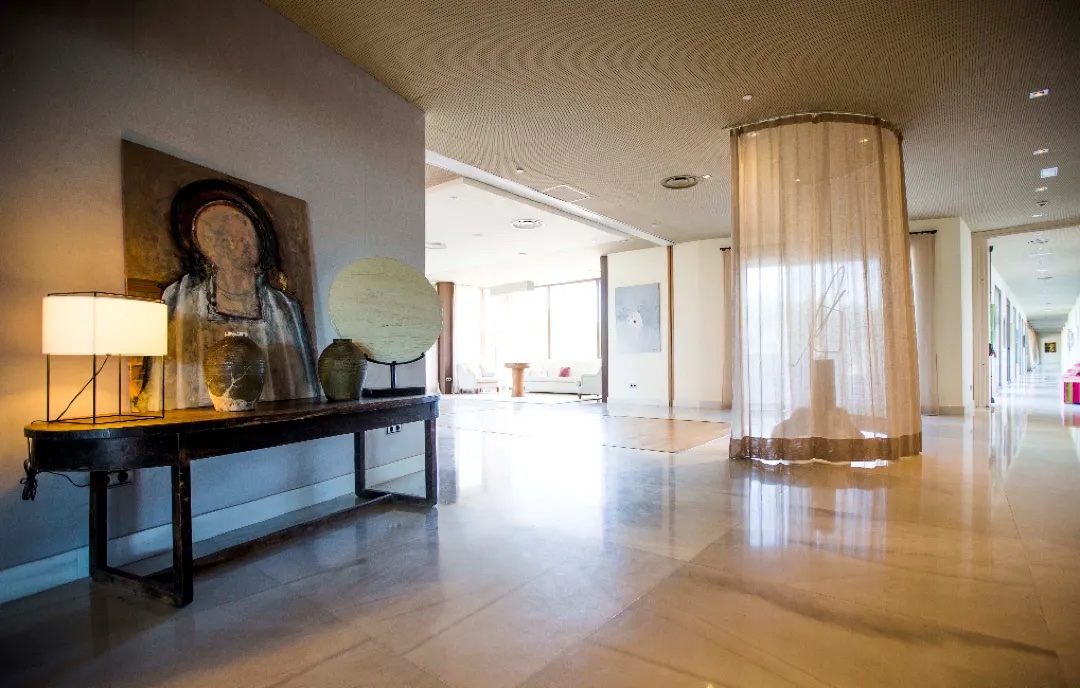
COVID rules and restrictions
All the usual restrictions were underlined and applied, e.g. social distancing, masks, hand sanitisers, etc. For the breakfast buffet they had a one-way system with hand sanitisers at the entrance. And in addition they provided disposable gloves at the entrance and long serving utensils at the different serving stations.
The room
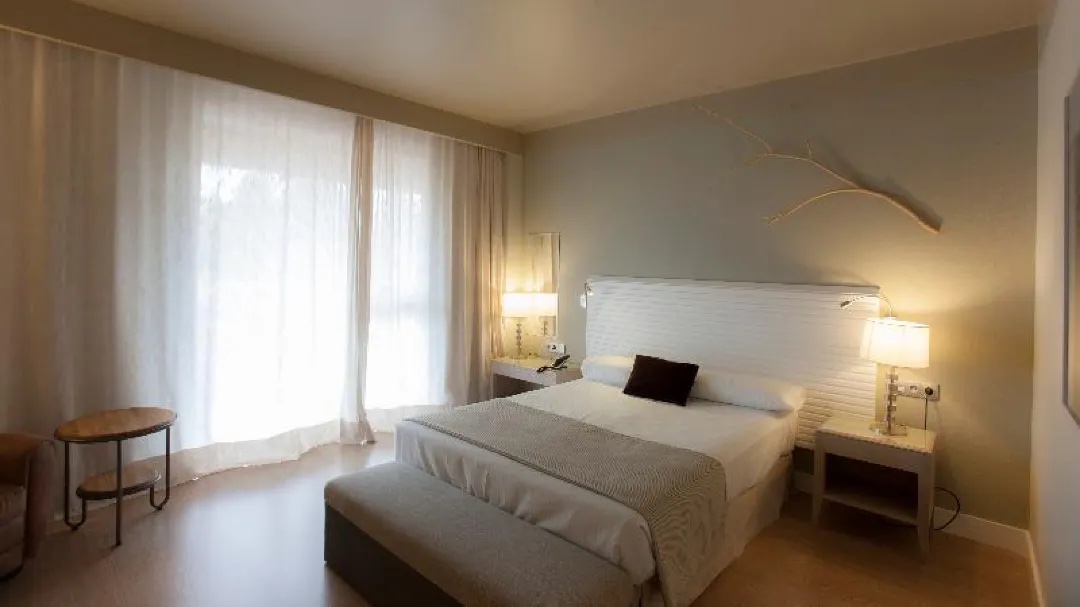
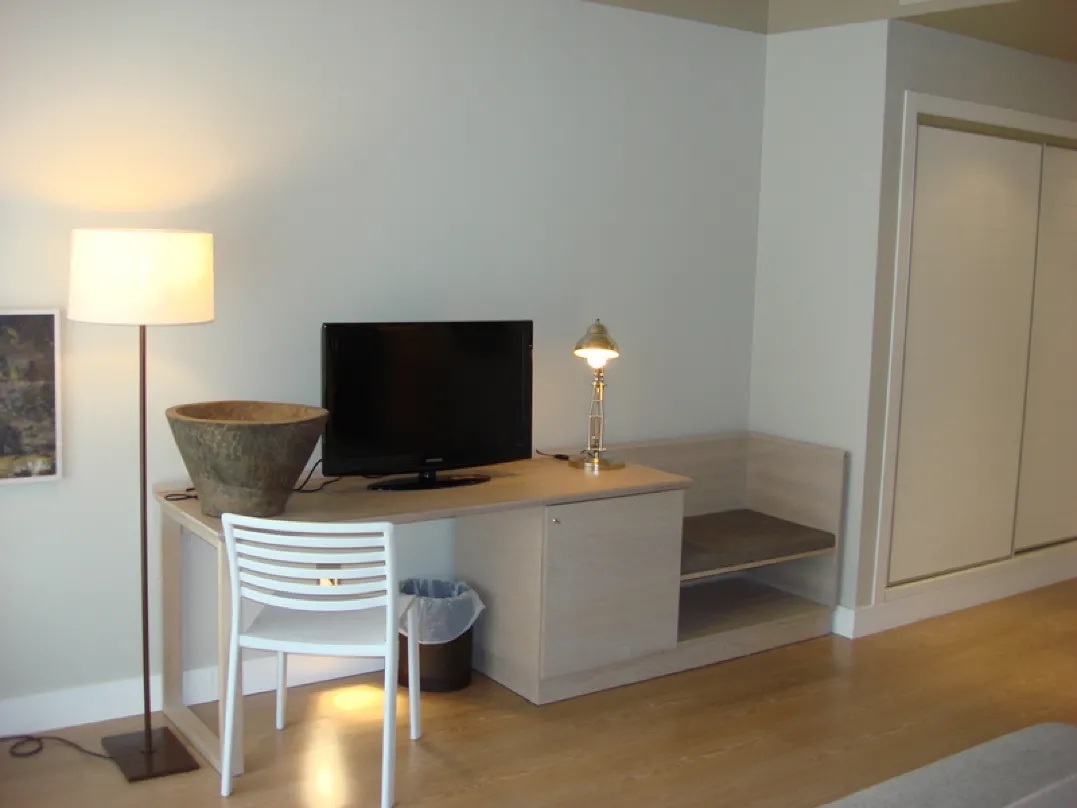
We can see that the room was simple and functional, and if everything had been perfect, an ideal stop-over whilst driving through Spain. However my wife found the mattress a little hard, and the balcony was not that inviting with its simple wooden chairs and rusty-dirty hand rail. We had asked for a walk-in shower and were given a room equipped for handicapped users (we should have simply asked for a separate shower). The problem was that the shower was next to the door and the water overflowed onto the bathroom floor. This problem was known because the bathroom door was clearly showing signs of water damage.
Otherwise the room was perfectly serviceable, even if there were only three coat hangers.
The restaurant
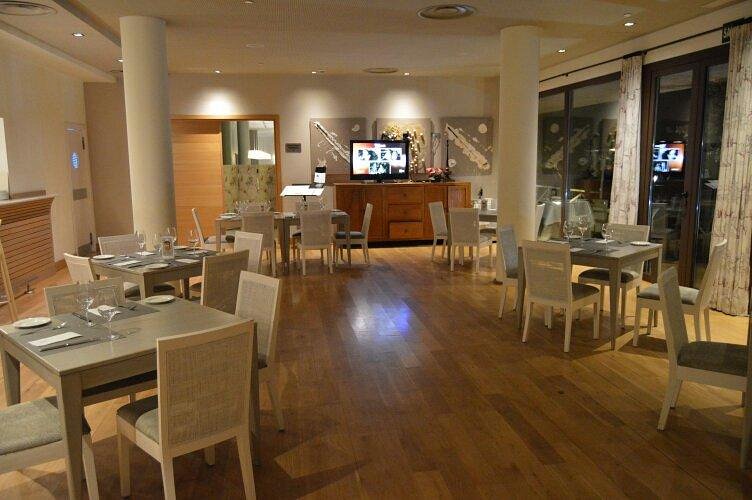
One of the fantastic things about a golf restaurant is that normally it serves from about 08:00 for breakfast until late for the last people coming off the course. Here the restaurant served the full menu all day until 23:00, so we could sit down to a glass of cava and good meal at around 17:00. The menu was quite complete and offered a number of attractive options.
The down side in this particular restaurant was that the comfort and decor was not that inviting (functional but not more). The views were fine, but not particularly attractive, and the terrace was just some old wooden seats on a gravel base. The service was friendly.
We started with Jamón Ibérico de Bellota D.O. Guijuelo which was totally fantastic. My wife then took the Ensalada de Quinoa y citricos con Brontes Tiernos y salsa de Yogurt Greigo (Bady leaf salad with Quinoa and citric fruit, with a Greek yogurt sauce). Very health and tasty, but perhaps not the best choice. I took the Solomillo de Retinto Extremeño ahumado al Carbón de Encina y Enebro (Smoked beef tenderloin from Extremadura) which was tasty but not very tender (see photograph below). My wife finished with a Tulipa de Helado (ice cream). No criticism of the menu or kitchen, but sometime the best value and tastes are found with the starters, e.g. Jamón Ibérico, local cheeses, croquetas, langostinos al curry, or salmorejo.

Breakfast was served in another room just next the dining room. There was everything you could need, except that they gave my wife mint tea instead of green tea (so for once she had to be satisfied with English breakfast tea). COVID rules included a one-way system, the use of long tweezers to take things, and obligatory plastic gloves, and of course face masks.
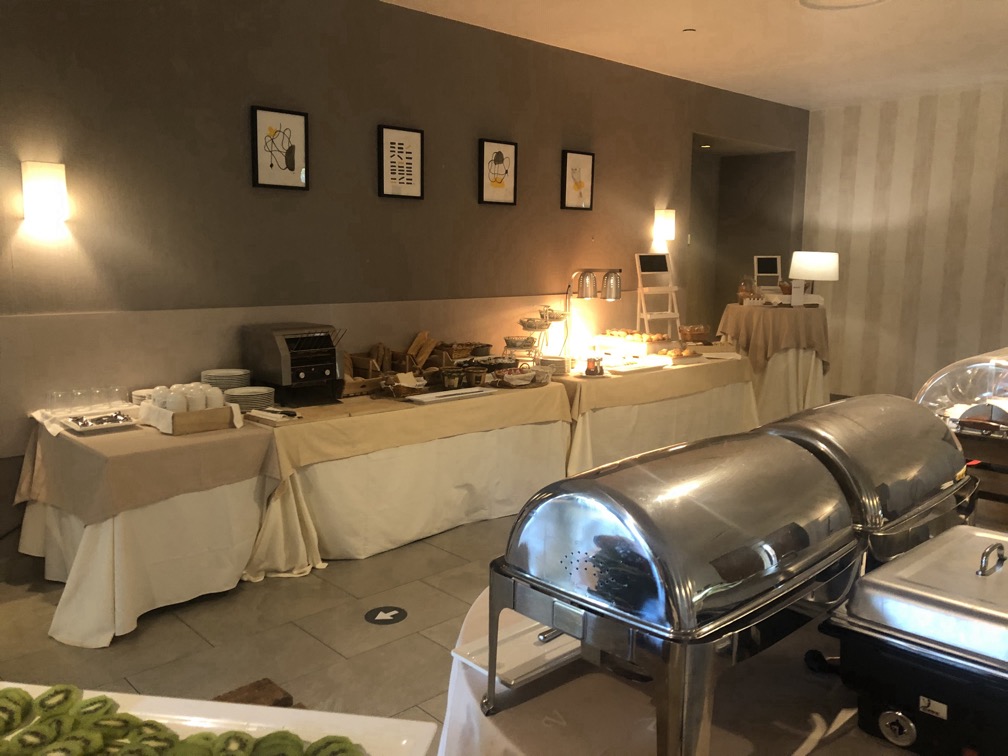
The environment around the hotel
The Vincci hotel mentions an 18-hole golf course, swimming pools, horse riding, an artificial beach (temporarily closed), hiking routes and a fully equipped sports centre. During our short stay we only saw the golf course, swimming pools and the artificial beach.
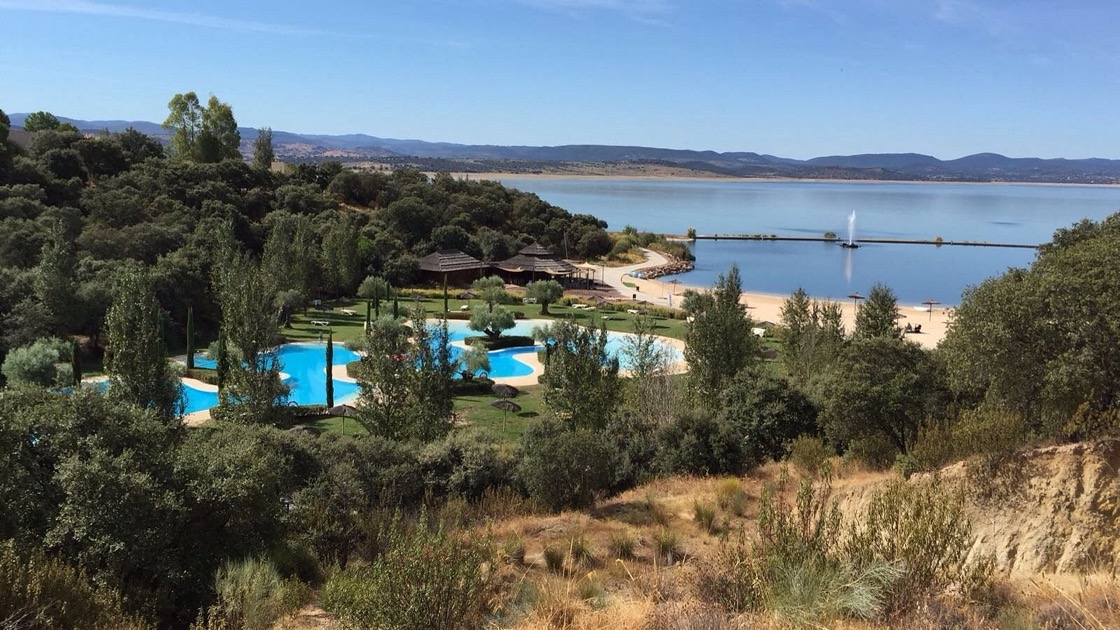
The pools and artificial beach are often presented as above, however when we were there the pools were said to be open, but the beach was closed and its artificial lake looked half empty. I'm more inclined to go with the below photograph where we can see the buildings that remain unfinished and are now condemned.
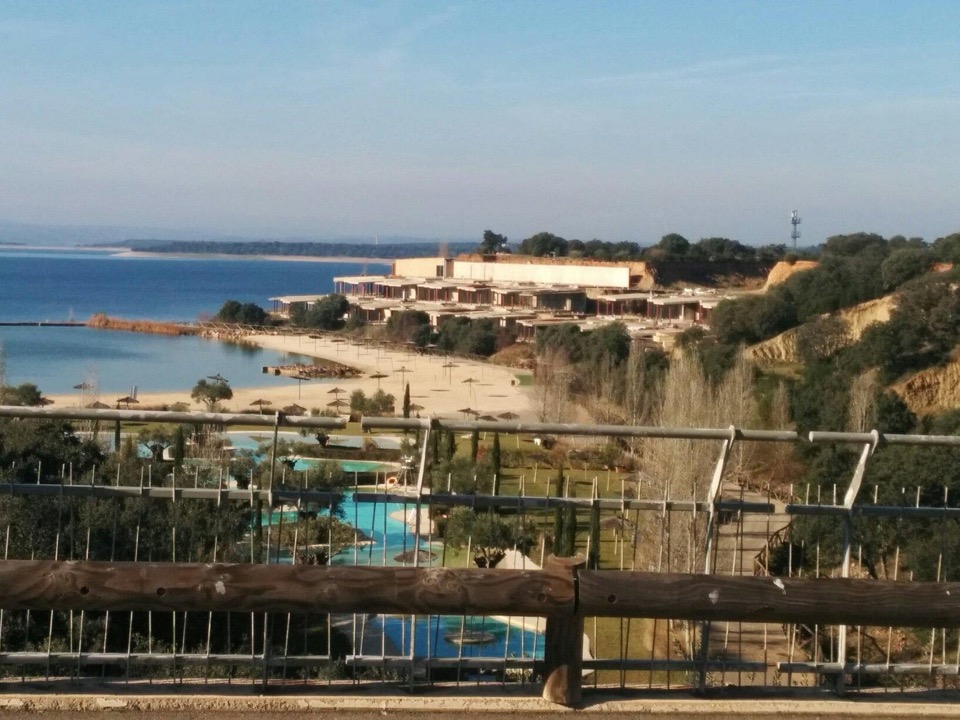
Concerning the golf I'm inclined to think that it is properly maintained, very reasonably priced (€ 39 to € 49 green fee), and as a par 72 with a slope of 143, it could offer a good challenge.
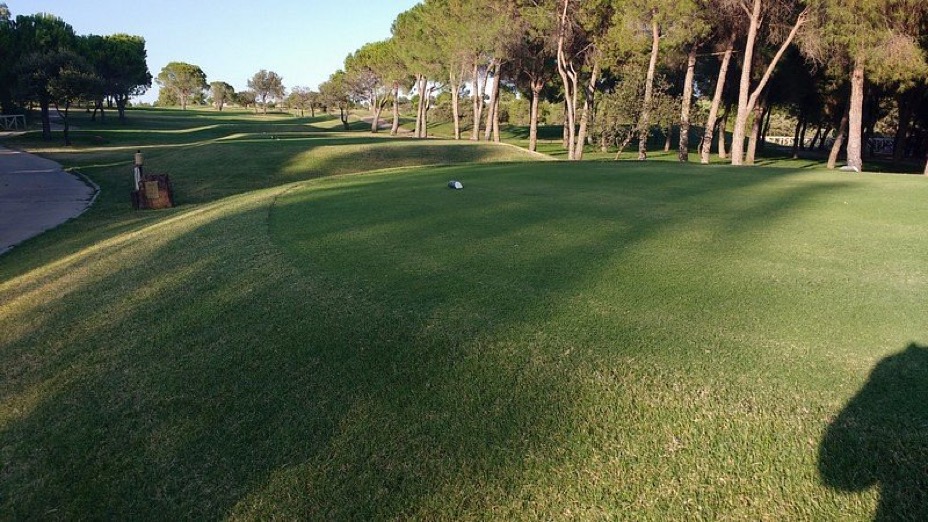
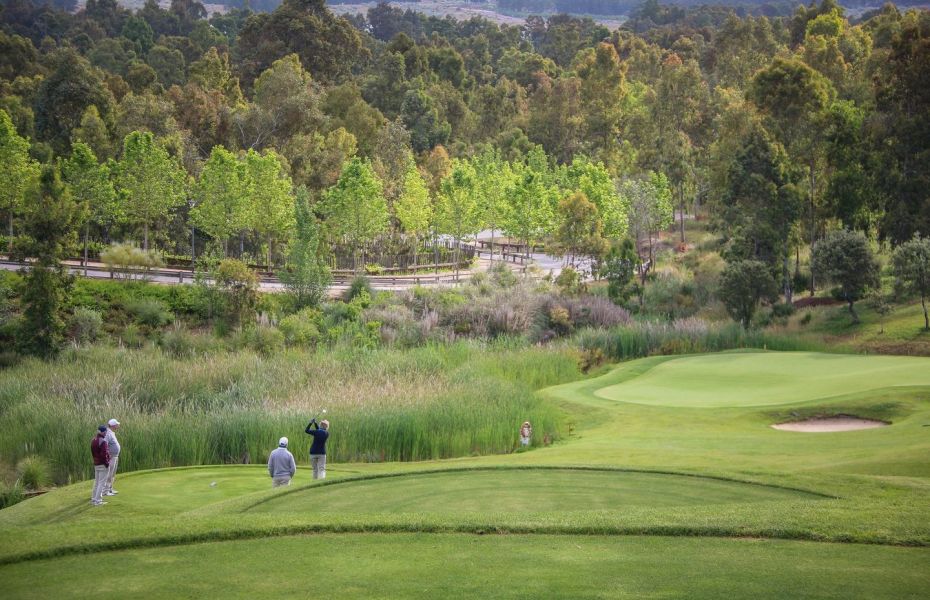
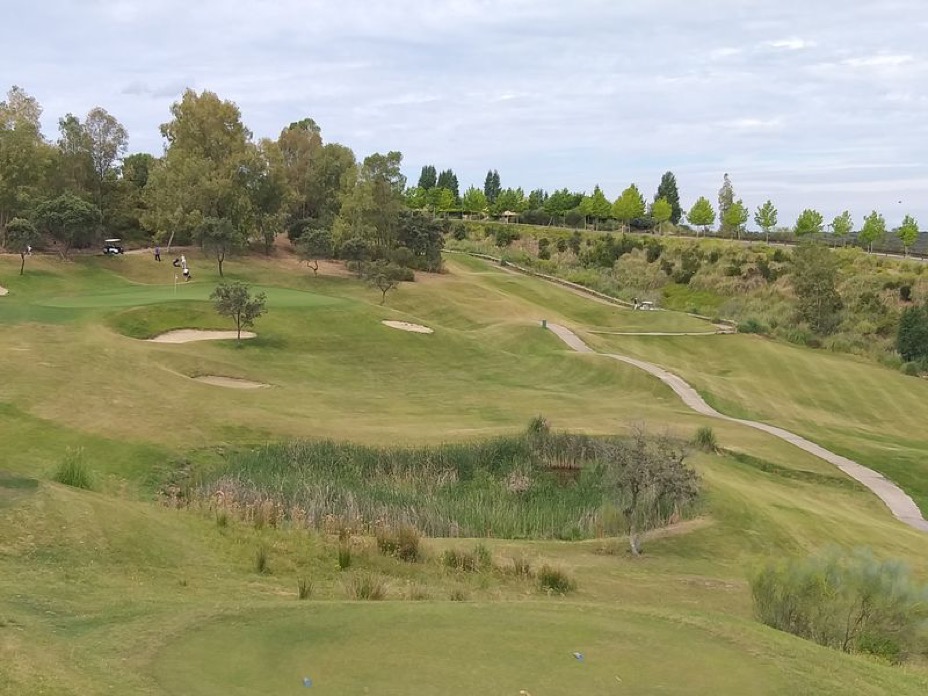
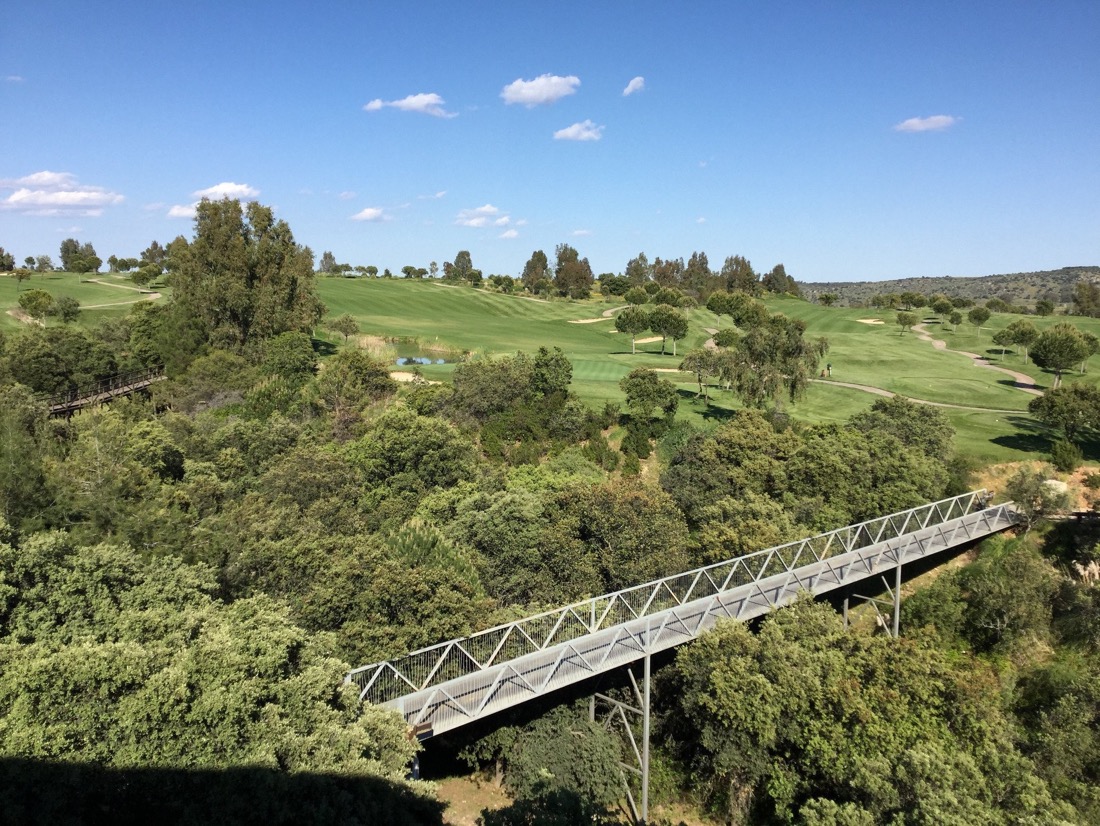
Conclusion
Positives:- Quiet, of-the-beaten-track, and not crowded during a summer weekday (weekend's might be different). The underground parking was welcome. Fantastic Jamón Ibérico at dinner.
Negatives:- We hate plastic shower curtains, and the shower overflowed on the bathroom floor. No green tea at breakfast. Main courses for dinner were not perfect.
Would we stay there again? Frankly, we would certain prefer a better alternative. However, normal rooms with normal showers do exist, the site is quiet and safe, and the underground garage was useful. I'm just not convinced that the room plus dinner and breakfast was worth € 214.40.
During July 2021 we stayed in five different hotels, some reservations made directly with the hotel and some through a booking agency. I'm not sure if it is a post-COVID characteristic, but my impression is that they now send out more contact emails than in the past.
We booked this hotel with Booking, but not using their app. Naturally we received an email confirmation of our booking, which had included a couple of additional requests concerning the room and parking. Five days after making our booking and ten days before our visit we received a positive reply concerning our special requests. Four days before our reservation we received from Booking a reminder, telling us we could cancel without a charge up to 2 days before our visit. Two days after our stay we received a "satisfaction survey" from the hotel. That's only four emails, whereas our other two reservation with Booking, resulted in 14 different emails each.
The history of Extremadura's paradise for VIP's
During our visit I happened to read a report from 2018 on the possible demolishing of the Marina Isla de Valdecañas, which they termed "el paraíso extremeño de los vips" (Extremadura's paradise for VIP's) and the "el último paraíso de los vips patrios" (the last paradise of the patriotic vips), and even the "Marbella extremeña" (Marbella Extremadura).
But first let's start at the beginning.
Hidroeléctrica Española was founded in 1907, and obtained the concession to exploit part of the Tagus (Tajo) and its tributaries in 1956. Between 1957 and 1963, they constructed in the Tagus basin a dam near Valdemoreno, which then created the Valdecañas reservoir (it was one of six dams the company built at the time).

We have to remember that the Tagus (Tajo) is the longest river in the Iberian Peninsula, flowing for 1,102 km, emptying near Lisbon, where it forms one the world's largest estuaries. Given that the drainage basin (>80,000 square kilometres) is the second largest in the peninsula, it's not surprising that it's home to several dams and reservoirs. In fact the total storage capacity is nearly 14 cubic kilometres, of which 80% is in Spain, and the installed hydropower potential is about 3300 MW. The 1998 Albufeira Convention is the legal framework that regulates all transboundary basins between Spain and Portugal and avoids any potential conflicts.
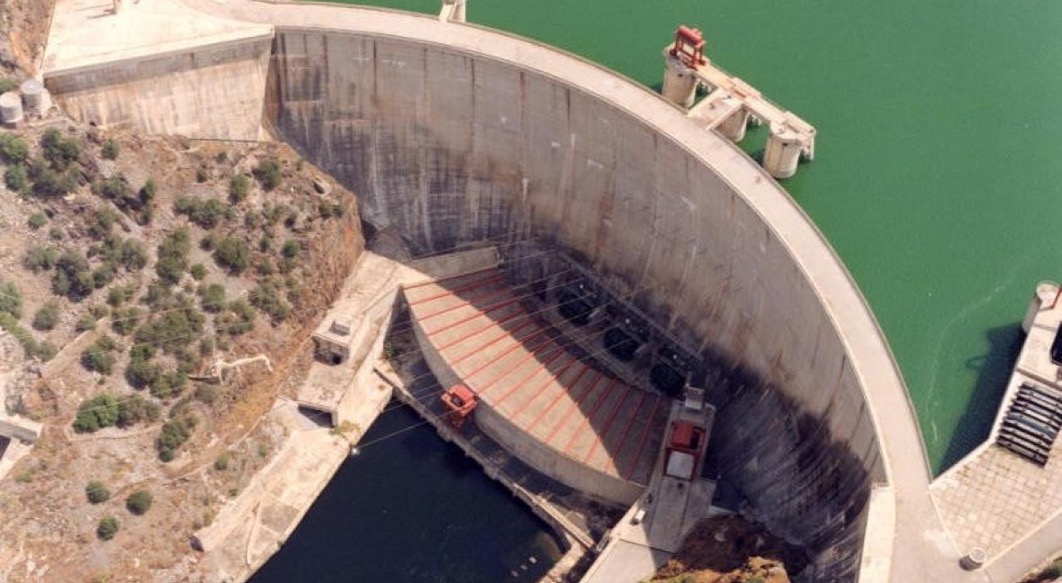
The dam was completed in 1964, and inaugurated by Franco in June 1965. It is an arch dam, so a dam that is curved up-stream and with the water pressure distributed to thrust blocks set in each of the side walls of a narrow canyon. The total height is 317 metres, consisting of a dam wall of 98 metres (so what would be called a "high" dam). The length of crest (top) is 290 metres, and the length of the toe (bottom) is about 100 metres. The width of the crest is 5 metres, and at the base 24.8 metres. The total volume of the dam body is just over 260,000 cubic metres, and there are two spillways set at the height 300 metres, which we can't see in the above photograph. An analysis at the time concluded that the use of an arch dam rather than a gravity dam saved about 1 million cubic metres in the dam body.
The total capacity of the Valdecañas reservoir is 1.446 cubic kilometres, so about 10% of the total storage capacity of the entire Tagus basin. When full the reservoir would cover 73 square kilometres. This capacity makes the Valdecañas reservoir the 6th largest in Spain.
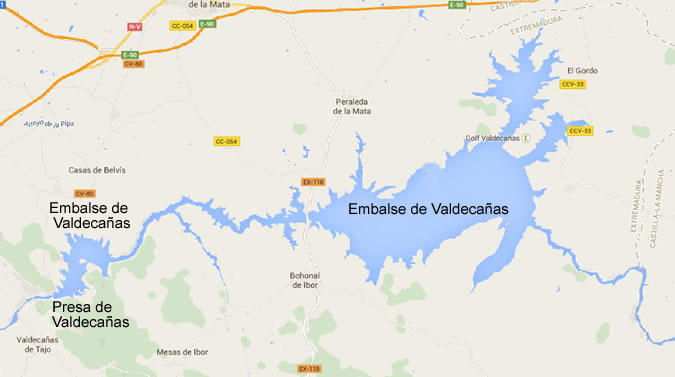
Averaged over the last 10 years the reservoir was nearly 47% full, whereas on our visit it was down to about 26% full.
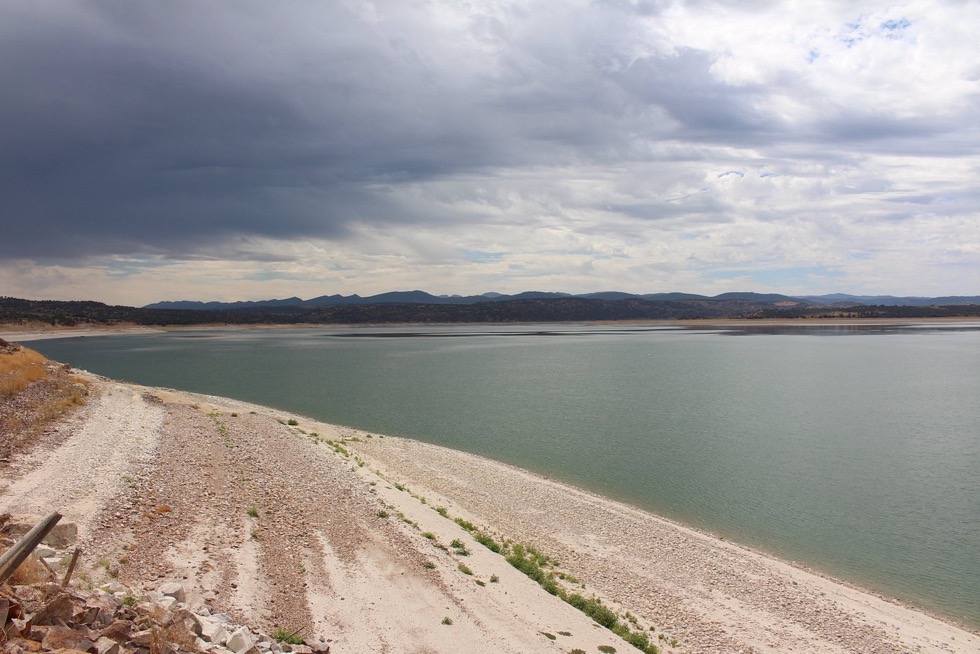
The dam is installed with three reversible turbines for a total installed power of 225 MW, able to produce one billion kW/h per year. Many such installations include a reversible pumping station with reversible turbines, which means that they can run in one direction as turbines and in the other direction as pumps. This approach was adopted from the 1950's in order to level the peaks and valleys of the electrical utility load curve, and as a way to ensure emergency power if needed. What it does is permit the units to work at constant output and best peak efficiency.
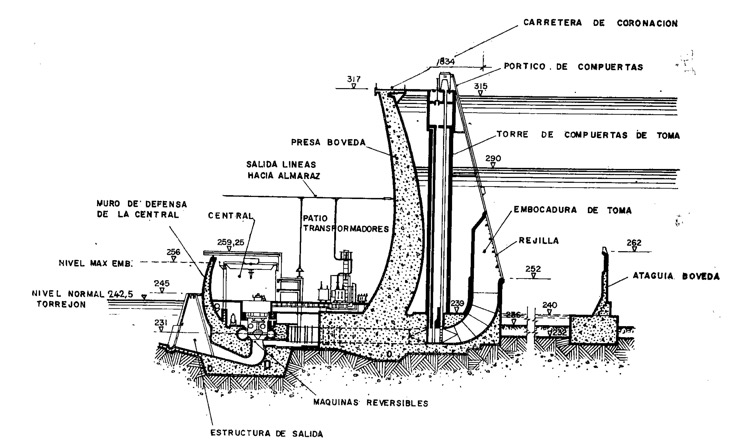
Here is a cross section through the dam, taken from one of the original publications "La Presa Bóveda de Valdecañas".
The different descriptions are less eloquent concerning the forced relocation of some two thousand local inhabitants, the displacement of the columns of the Los Mármoles temple to the lake edge, and the total submersion of the Guadalperal Dolmen.
It would appear that in early 2005 the Junta de Extremadura decided to declare the entire Valdecañas reservoir a ZEPA or Zona de Especial Protección (Special Protection Area), and in addition they requested the area's inclusion in the European Union's Natura 2000 Network. It's worth mentioning that the area had already been proposed in 1986 as land that should be protected from development for environmental reasons. In 2005 the builders claimed that the site had still not been "officially protected", yet there is ample proof that the actually request to declare the area a ZEPA was made in June 2003, and updated in November 2003 and again in 2005.
The ZEPA and Natura 2000 documents clearly highlight several important environmental features of the Valdecañas region. Firstly as a breading area for a variety of birds including eagles, and secondly as part of the Iberian lynx recovery plan. Overall it was stated that the reservoir (i.e. wetland) was important for wintering waterfowl, with very high diversity and wealth indexes.
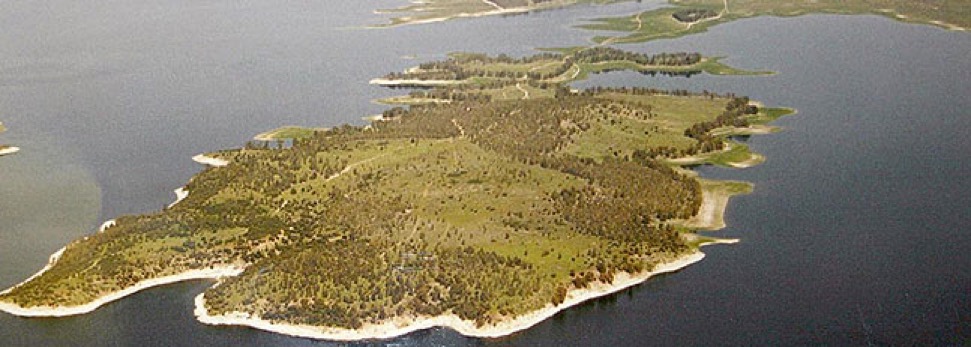
As the reservoir filled up it created at its eastern tail a small semi-desertic island of 134.5 hectares, an area of holm oaks and eucalyptus but of little agricultural value. The small island is actually about 20 kilometres upstream from the dam.
In 2005, Grupo Empresarial Marina Isla Antilla, SA, a company based in Seville and created in 2003, set up a company called Marina Isla Valdecañas, S.L., and two days later they bought the island of Valdecañas from two private owners (cost € 7.8 million) on the basis that the land could be developed. Here the assumption is that the developers already knew that the area would be declared as open for development and would be accepted as a Project of Regional Interest (PIR). On the isla, the team of Miguel Ángel Gea & Arquitectos designed a luxury resort (golf course, hotels and villas) called "Complex Tourism, Health, Landscape and Services Marina Isla de Valdecañas". I suppose the key was the site's excellent location, 175 km from Madrid, 90 minutes from the Madrid-Barajas international airport, and with accessibility guaranteed by the Extremadura Highway (A-5, km 163). In addition, at the time there were plans for an AVE Madrid-Lisbon, which was later cancelled in 2012.
The developers made an application to the authorities in October 2005 asking for the construction project to be declared a Project of Regional Interest (PIR). In November 2005 they were informed that the area was covered by ZEPA and Natura 2000, and that approval of any development would only be agreed "after having insured that no damage will be caused to the integrity of the place …". The developers replied that no ZEPA had been published, and the area should be excluded from any future publication (the ZEPA had already been in place since 2003). In December 2005, without submitting an environmental impact study, the developers were informed that their development was compatible with the environmental rules of the ZEPA. There should have been a report on the impact of the road, power lines, and the creation of a small dam to create a protected beach, as well as how the project would have been integrated into the environment.
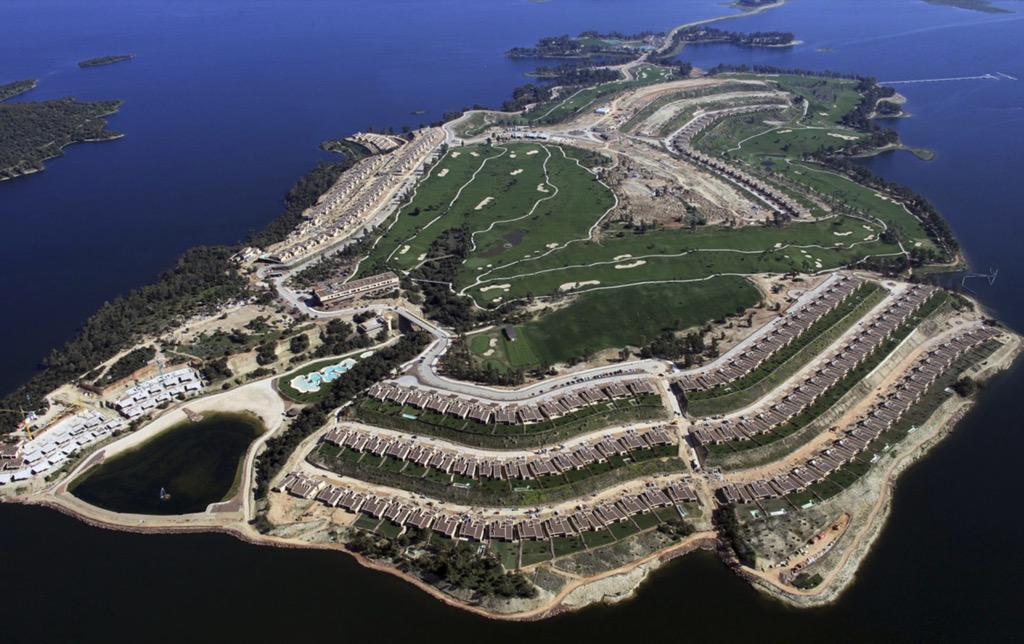
In 2005 the developer was selling the idea of "two hotels, 300 villas, apartments, a golf course, a sports complex with space for 76 berths, a swimming pool area and an artificial beach" (see the above first phase plus initial building for the second phase). The average price for a piece of this dream location was € 550,000, yet it was said that they had no problem finding 183 buyers for the first phase of construction. We must remember that starting in 2006 the housing bubble in Spain started to implode, but the developer went ahead and began the construction of the hotel and the first houses despite the impending crisis. The initial investment was for about € 140 million, with the creation of a 4-star hotel with 80 rooms, golf course, jetty, artificial beach, dike, and sports facilities. Locals are said to have considered the location "a secarral", a arid area, so the first phase also included the planting of 200,000 different trees and shrubs and the turfing of more than 75,000 square meters (all presumably associated with the golf course).
The builder, a certain José María Gea (apparently the builder of a complex at Islantilla in Huelva), handed over the marketing to Beltrán Gómez-Acebo, son of Doña Pilar de Borbón and nephew of the King Emeritus Don Juan Carlos, and Jaime López-Ibor Alcocer, grandson of the prestigious psychiatrist Juan José López-Ibor and nephew of businessman Alberto Alcocer. And this marketing ploy appears to have worked, because it is reported that homes were bought by both well-known families, e.g. Aznar, Gómez-Acebo, López-Ibor, Vega-Penichet, Carlos Baute, Fran Murcia, etc., and "lesser knowns" but with privileged positions on the boards of Banco Santander, Banca Rothschild, Telefónica, Bank of América, Credit Suisse, etc.
In January 2006 the architects were assuming that the land was classed as undeveloped, and that it would need to be reclassified to allow for an urban development. Lawyers requested that the land be declared as available for building, and accepted that the usual rules concerning planning, protection of the environment, etc. would be respected (but no mention of the ZEPA). The Secretaría de Presidencia of the Junta de Extremadura noted that there was no legal barriers to the development project and therefore it could be declared a Project of Regional Interest (PIR). The chronology of the different steps in the decision making processes (what documents were included or missing) was quite complex and is summarised here.
Finally it was in April 2007 that Juan Carlos Rodríguez Ibarra, in the Junta de Extremadura, approved the "elitist" urbanisation as a Project of Regional Interest (PIR). The decision was immediately challenged by Ecologistas en Acción (Ecologists in Action) and Adenex (Asociación para la Defensa de la Naturaleza y los Recursos de Extremadura). The legal basis of the complaint was clear, the land was part of the Red Natura 2000 (Natura 2000 Network), and as such could not be built upon. The decision dating from April 2007 did include quite a number of necessary "corrective and compensatory measures". In March 2007 the costs of the first phase of house construction were estimated at just under € 40 million, yielding a profit of 6% for the developers.
During the different challenges posed by Adenex, in July 2007 the reservoir was emptied to allow building to start. However this action had not been mentioned or evaluated in any environmental impact study.
When challenged the approach taken by the Junta de Extremadura was to effectively remove the Marina Isla de Valdecañas area from the list of Zona de Especial Protección (Special Protection Area). In November 2008 a decree definitively approved the land and territorial Planning for Campo Arañuelo, i.e. the entire region including the Valdecañas reservoir. Technically there was no provision for projects such as the Marina Isla de Valdecañas, since the entire reservoir was declared nourbanizable, i.e. an environment protected from development. However the territorial plan exempted any development that had already been approved as a Project of Regional Interest (PIR), i.e. the Marina Isla de Valdecañas was the only PIR in that situation. Adenex argued that the territorial plan had been delayed from 2004 and only approved one month after the PIR for Marina Isla de Valdecañas had been approved.
In March 2009 El Tribunal Superior de Justicia extremeño (The Extremadura Superior Court of Justice, often abbreviated TSJEx) judged that tourist developments such as the Marina Isla de Valdecañas could not be the subject of a Project of Regional Interest (PIR), and in July 2009 there was a request to nullify the PIR and to demand the restoration of the land to its original state. However, "administrative delays", meant that the work continued until October 2009 when finally the court decided not to stop the work because (a) it was justified by a urban plan, (b) that the promoter would suffer economic damage if the work stopped, and (c) the environmental protection measures were already in place. In December 2009 Adenex filed against this decision of TSJEx, but it was dismissed. In May 2010 a new urban plan was published for El Gordo, including the new Marina Isla de Valdecañas, which in fact constituted 90% of the new land re-classification. Oddly, the rest of the area around the Valdecañas reservoir was deemed of high environmental importance and was protected as such. Adenex filed against the new urban plan, but it was dismissed. In October 2010 the Suelo y Ordenación Territorial de Extremadura (Land and Territorial Planning of Extremadura often known as LSOTEx) included as part of the PIR the tourist projects associated with the reservoir and the golf.
In March 2011 TSJEx finally sided with an appeal by Adenex. Firstly, it concluded that Marina Isla de Valdecañas could not be a Project of Regional Interest (PIR) because there was no justification as to why the project had to be carried in a ZEPA, and not elsewhere. Secondly, they also concluded that LSOTEx should not have included the tourist projects associated with the Marina Isla de Valdecañas because these types of project can't be Project of Regional Interest (PIR). It also recognised the fact that the land was under an environmental protection order, including Natura 2000, and that state law did not have the discretionary power to change that classification.
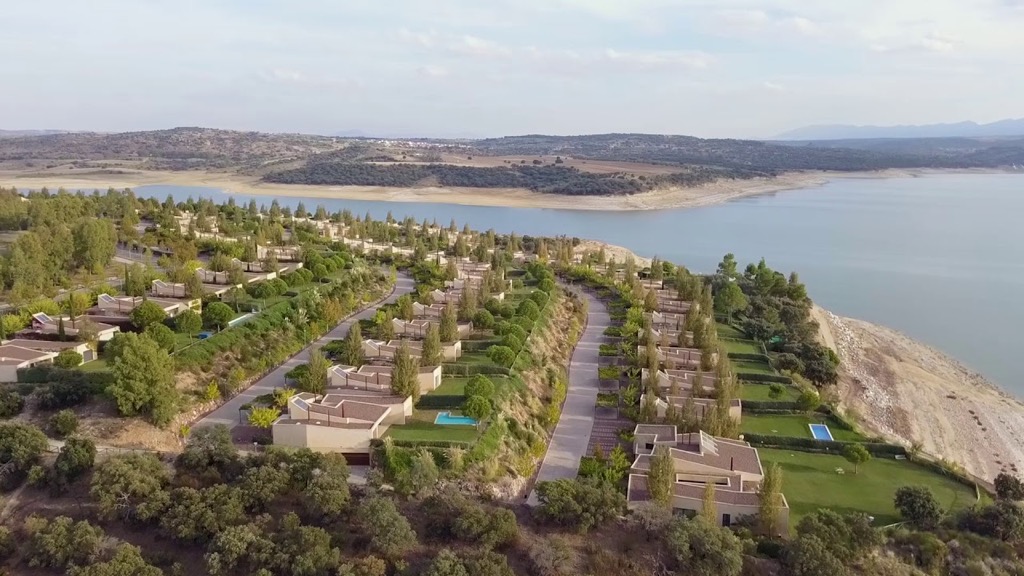
So six years after the start of the construction, El Tribunal Superior de Justicia extremeño (The Extremadura Superior Court of Justice, often abbreviated TSJEx) finally agreed with the ecologists, and ordered "the restoration of the land to the situation prior to the approval of said project". This would be just the first sentence of a long judicial battle that still today (July 2021) does not have final decision.
Just 20 days later the Junta de Extremadura amended article 11 of their Ley del Suelo de Extremadura (Extremadura Land Law) to allow building in protected areas, including retroactively. This change of the law was approved by both the PSOE and PP, and with it the Junta de Extremadura effectively froze the Supreme Court decision to demolish the site. Changing the land law rendered the different cases brought before the Spanish courts defunct. However, four years later, the Supreme Court would uphold the first sentence and force the sites demolition.
In April 2011 Adenex requested the nullification of the Project of Regional Interest (PIR), the termination of the work on site, and the annotation on the property registry of the sentence (this request was supported by the public prosecutor). The Junta, Marina Isla Valdecañas and the Diputación de Cáceres appealed this request, because it would have affected the completion of the project and the sale of properties. The appeal was upheld. There followed a kind of dog-and-cat fight between the local authorities and Adenex, centred on the poor quality of the environmental assessment report and the fact that the habitat of a species in danger of extinction had been destroyed. However, the local authorities went ahead and definitively approved the development project for the Marina Isla Valdecañas, including the changes to the land law.
Along with the legal battle, another battle emerged. Adenex requested from the court the right to justicia gratuita, or what would probably be called legal aid. They had to demonstrate that they did not possess sufficient financial means to fight their case in the courts. In addition TSJEx issued a provisional enforcement of the judgement for the nullification of the Project of Regional Interest (PIR), but ordered Adenex and Ecologists in Action to provide a bond or guarantee of € 41 million, which they challenged. Not able to provide the bond, the provisional enforcement was not carried out. This did not stop the continued appeals and counter-appeals concerning the construction project. Adenex continued to look to the nullify the Project of Regional Interest (PIR), whilst the authorities and developer claimed that the new land law was operational and the project was of benefit to the local environment. The Supreme Court rejected the appeals of Adenex, given that they had already won their case, and they just have to provide the € 41 million bond.
In December 2012 the management plan for the Embalse de Valdecañas was finally approved, almost 10 years late, and when all the buildings built in the first phase had already been sold. As Adenex consistently pointed out, both the issues of the protection of local flora and fauna and of the quality of the water, had been left for later. In April 2013 legal aid for Adenex was agreed by TSJEx, but they also confirmed the need for a € 41 million bond in order to stop the development work.
Finally in January 2014 TSJEx confirms the original sentence against the development project, and ordered them to pay all the costs in the demolition of the site and the need to return the site to its original state. The chronology I mentioned earlier stops here.
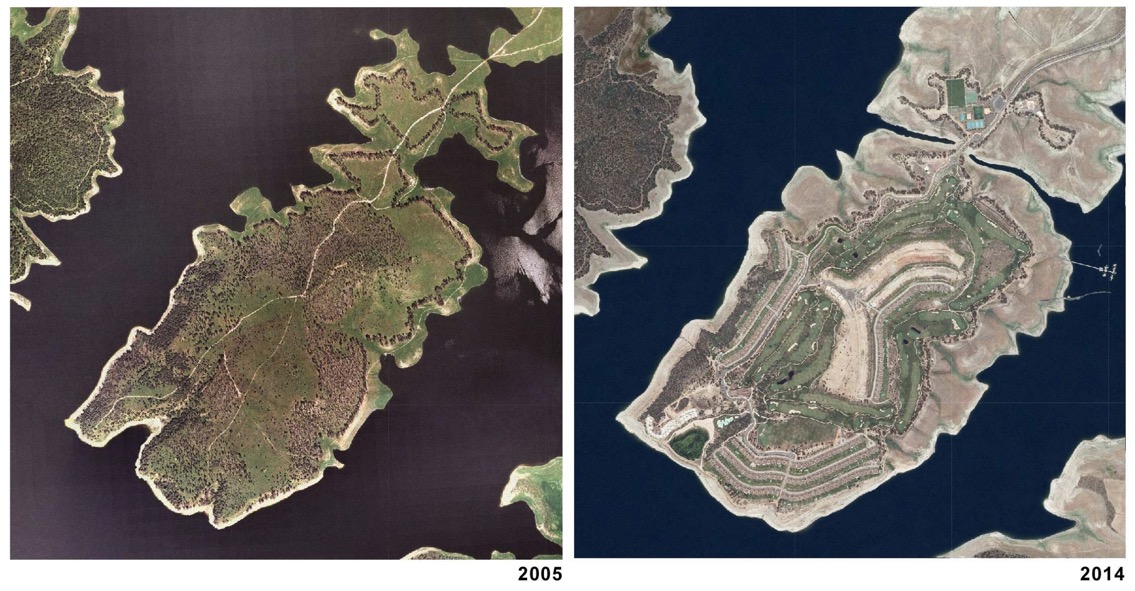
Above we can see the changes that occurred on the island from the first objection of Adenex in 2007 through to the "final" victory in 2014.
The TSJEx decision had important economic consequences, since it had been estimated that it would cost € 34 million to demolish the complex and return the site to its initial state. For this reason the court was urged to request an independent expert evaluation before the execution of the demolition. TSJEx accepted the request and commissioned the Estación Biológica de Doñana (Doñana Biological Station) to prepare a separate environmental report. The problem was to find out what was better for the ecosystem in the area, i.e. leave the complex in place, or tear it down and turn the site into a huge dump that could further damage the current protected habitat.
While awaiting the judicial decision, the companies associated with the development filed for bankruptcy. Naturally the problems with the site and court decisions adversely affected sales, with some of the houses re-selling for less than € 400,000, and subject to the final outcome of the legal battle.
There were two problems that both the court and the separate environmental report had to address. Firstly what was the true environmental value of the site before the building, and secondly what happened in 2007 when the reservoir was dried to permit the construction of the site. The overall conclusion was that the site had been important from an ornithological point of view, and that the emptying of the reservoir had been detrimental to the local flora and fauna. Naturally, set against this was the fact that the project would have created a large number of jobs, and given an economic boost to the region. Equally important was the fact that site was almost empty during weekdays, and the hotel and golf course only woke up on weekends. However, due to a lack of investment the complex started to look a bit dilapidated, and the artificial beach, once filled with lake water, was only half full.
The originally plan for an exclusive private island with two hotels, a golf course and more than 500 homes deluxe was dead. But the TSJEx had also to assess the socioeconomic impact that the completed urbanisation would have produced in the nearby municipalities, and remembering that both the hotel and the houses already built were only a part of the original project. One hotel was finished and in operation, and the second was partially completed. Only 185 villas had been completed of the 565 residences originally envisaged. Nevertheless the site had already created 35 permanent jobs and another 65 temporary jobs, and almost double that indirectly. In addition, the local village El Gordo had received € 300,000 in taxes, etc. Local officials noted that "half Extremadura cannot be declared as a ZEPA, or it would be impossible to prosper". They noted that Special Protection Zone affects some 7,600 hectares, yet the Valdecañas Island represents less than 2% of the total. On top of that the location had served for years as a landfill for the region. I also remember a story of a person killed in the same location because it was being used to detonate old ammunition.
With the original builders now bankrupt the cost of about €34 million for the demolition work would have to be paid by the Junta de Extremadura. In addition they would almost certainly have to pay out another € 111 million in compensation to homeowners who had bought homes in good faith, etc. So the Junta de Extremadura would be facing a bill in excess of € 145 million to remove all the past construction work from the island.
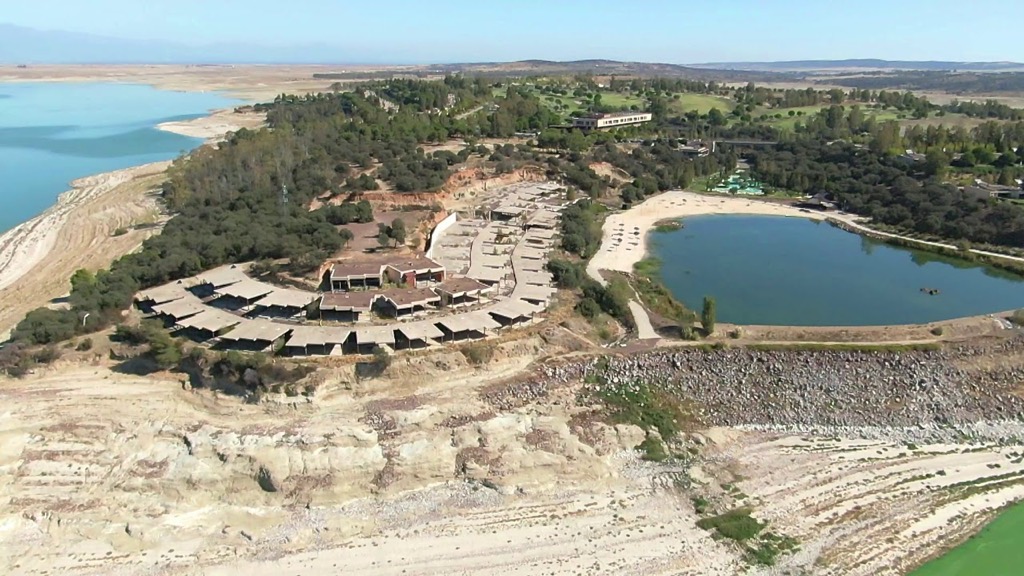
In 2020 TSJEx finally decided that what had already been build and was in use would not be demolished, but everything that was not yet finished should be demolished (as seen above). This included the unfinished second hotel, the unfinished houses, and the houses not yet sold (including the developers office and show house). The decision was described by the ecologists as indignante (outrageous), whilst owners considered it equilibrada (balanced). The argument was that the decision would avoid damage to the environment (i.e. that produced by removing the hotel, occupied homes, golf course and working facilities), but by removing all the incomplete buildings it would allow revegetation.
The TSJEx ruling allowed the first phase to remain because "due protection of the environment is guaranteed". They also stressed the "socio-economic impact" of the development, "as well as the serious economic damage to the Public Treasury that would occur if everything built was demolished". The court also took into account the "protection of third parties, the principle of legal certainty and the time elapsed from the filing of the appeals (2007 to 2020)".
Owners welcomed the good news and expresses their willingness to carry out the necessary work to comply with the judicial resolution and make the island "an example of coexistence between people and the natural environment". They reminded everyone that the island itself had no ecological value, was part desert and part landfill, but "today was a model of biodiversity, with a flora and fauna that did not exist before the development".
Ecologists in Action and Adenex expressed their "outrage" at the decision, which they felt was just accepting an illegal project by way of fait accompli. They stressed this "glaring case of non-compliance with environmental and urban regulations" and the fact that "all the judgments have confirmed the illegality of the urbanisation". The two groups felt that the judgment of the TSJEx was "outrageous and incomprehensible in a true rule of law, since the ruling openly contradicts the result of the expert test carried out by the Doñana Biological Station, which clearly stated that the impact of maintenance of the urbanisation is far superior to that of its demolition".
Ecologists in Action (Adenex stepped back for financial reasons) presented on November 9, 2020, an appeal before the Supreme Court. It is based upon the idea that a decision cannot be based upon simply declaring "the partial material impossibility of executing the sentence". They argue that "it is not that we ecologists want to demolish the entire complex, but rather a sentence of the Supreme Court ratified by the Constitutional Court says so".
So as of March 9, 2021, which marked the 10th anniversary of the first judicial order against the tourist complex, the Supreme Court still has to take a position against a new appeal presented by environmentalists. They consider that demolishing the second phase of construction and leaving the current phase in place (as ruled by TSJEx on June 30, 2020) is still completely inappropriate.
The Junta de Extremadura, which originally endorsed the urbanisation, has proposed a regeneration of the area with the implementation of 53 actions to be carried out in 35 months for the 'revegetation' of the place. This includes environmental monitoring, creation of two treatment plants, and signs and information about the importance of ZEPA. These measures have been endorsed by the TSJEx, which has urged the authorities to implement them as soon as possible, regardless of the final resolution of the Supreme Court, "because they are clearly beneficial for the environment".
The demolition of the second phase of the development will take at least three years from its inception, and will involve removing the foundations of almost fifty houses, and the destruction of the second hotel and of the finished houses that served as the offices and show house.
The Guadalperal Dolmen, or the 'Spanish Stonehenge'
The official record specifies that the Tagus is an area rich in megalithic necropolises and that their location is not arbitrary, but rather responds to relationships with the territory and landscape landmarks, with which they were intimately linked.
The Guadalperal Dolmen were discovered in 1925 by the German archaeologist and priest Hugo Obermaier, professor of Primitive History. In the following two years he excavated the site, and restored, relocated and stabilised the orthostats with concrete, in addition to protecting them with a brick perimeter fence to prevent the entry of livestock. What emerged was a spectacular megalithic funerary complex formed by 144 stones, all between 5,000 and 7,000 years old (so older than the Pyramids).
Typologically, the dolmen is a corridor tomb with a burial chamber 5 meters in diameter and a long corridor almost 10 meters long and 1.5 m wide. According to the conserved inventory, the set is made up of 140 ostostats and among them is a menhir inside the chamber (with a possible millennial map of the Tagus River) and a large anthropomorphic menhir stela erected in front of the entrance.
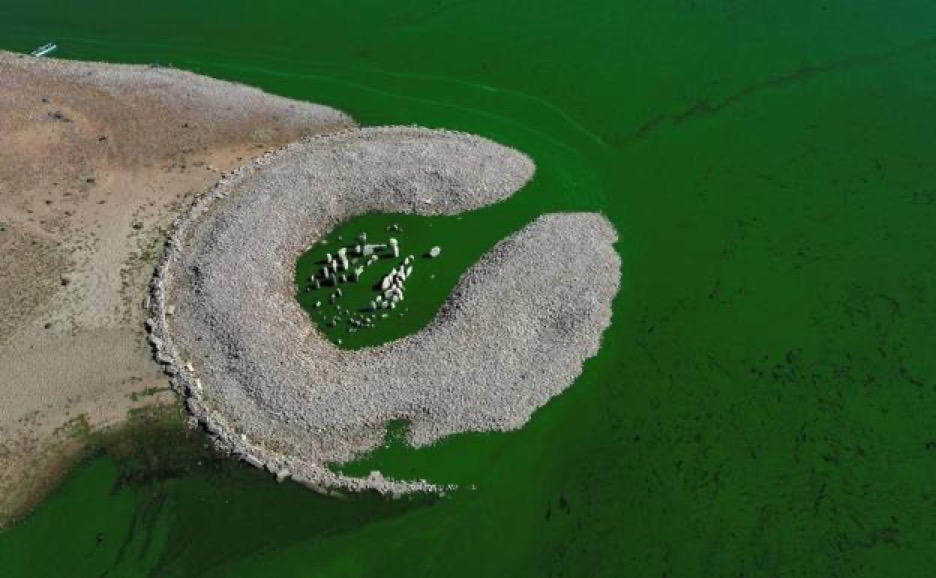
In 1963, due to the construction of the Valdecañas reservoir, the land was expropriated and included in the reservoir area. The dolmen were permanently submerged and only on very rare occasions have they partially or totally emerged. During all these years, the currents have dragged the soluble or disaggregated materials, exposing the forest of orthostats and the set of stone bowls that originally formed the burial mound.
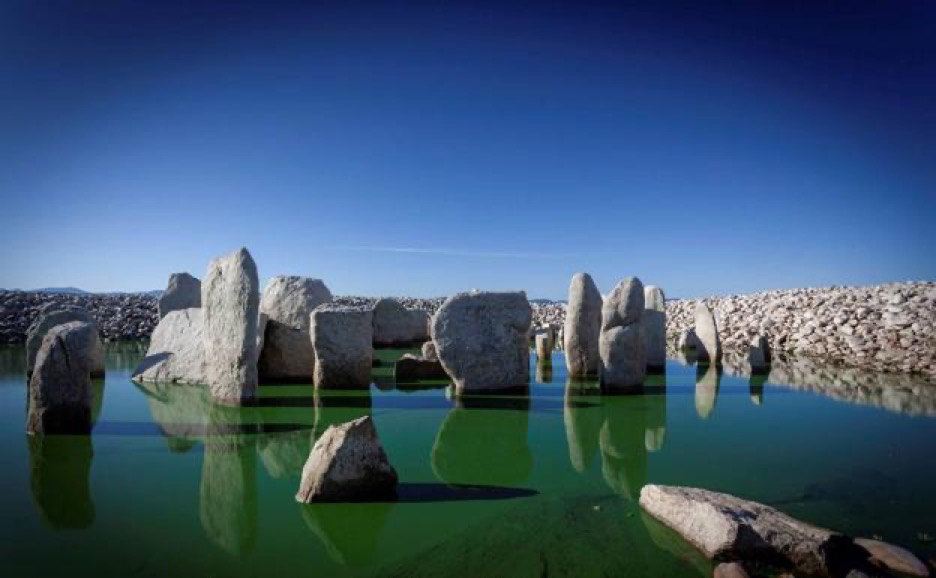
In 2019 Guadalperal Dolmen partially emerged, and during our visit in July 2021 the reservoir had fallen even more, to about 26% full. This meant that the Guadalperal dolmen had completely re-emerged from the waters of the Valdecañas reservoir, and were again being studied by archaeologists from the University of Alcalá de Henares.